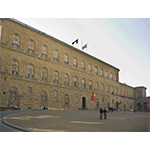Palazzo Pitti [The Pitti Palace]
Built around 1440 by Luca Fancelli on a project by Filippo Brunelleschi for the merchant Luca Pitti, it was purchased along with the land behind it by Cosimo I de’ Medici for his wife Eleonora di Toledo. In 1549, Cosimo appointed Buontalenti to create the adjoining Boboli Garden designed by Tribolo. The works to expand the building, entrusted to Florentine architect Bartolomeo Ammannati, were intended to transform Luca Pitti’s Renaissance construction into a royal palace. Ammannati’s participation concentrated on the large courtyard, veritable porticoed royal piazza. To the Pitti worksite, Bartolomeo Ammannati brought his theoretical-practical competence which he celebrated in the relief of the Mula [She-mule]. The protagonist of this unique monument to the Pitti courtyard worksite was, as the cartouche reads, the humble draught animal depicted in the foreground, waiting to lift one of the courtyard capitals. Also depicted in the relief are man and machine: the latter is represented, on the right, by a crane formed by a long pole equipped with pulleys and ropes and, on the left, by a hoist driven by the animal, which the man prepares to dismantle. This machine used to life great weights was fundamental at the worksites of the period.
In 1553, the Pitti Palace became the duke’s residence, and was enlarged and modified on several occasions up until 1783. Around the middle of the 16th century, Cosimo I began to assemble there precious art collections and works of nature, today conserved in the most important museums of Florence. During the years in which Florence was Capital of the Kingdom of Italy, it became the official residence of the House of Savoia. Today, it houses the Palatine Gallery founded by Grand Duke Leopold II in 1828, the Gallery of Modern Art, the Costume Gallery and the Museo degli Argenti (the Medici Treasury). The Pitti museum complex also includes the Porcelain Museum and the Carriage Museum. The Palace still conserves a sundial, realised in 1696 under the reign of Cosimo II, and housed in the Palazzina della Meridiana. It has a vertical and horizontal dial and is coordinated to function as both a clock and calendar, providing indications as to the day and month. Though intact, the sundial no longer functions, due to the later construction of a loggia on the upper floor which prevents the sun from illuminating the gnomonic hole.
In the course of the 17th century, the Pitti Palace was also the privileged venue of very important scientific meetings. As of 1640, Grand Duke Ferdinando II de’ Medici would assemble several scientists for the purpose of conducting natural observations. These meetings witnessed the participation of the Grand Duke, Evangelista Torricelli and Vincenzo Viviani. These sessions gave rise to the Accademia del Cimento, founded in 1657 by Prince Leopoldo de’ Medici and Grand Duke Ferdinando II de’ Medici, which was the first scientific society to be formed in Europe. Its primary purpose was the development and diffusion of Galilean experimental methodology in the field of natural sciences. The Accademia activity provided for a rigorously experimental verification of the principles of natural philosophy, till then supported on the basis of Aristotle’s authority. "Trying and trying again" was the motto that distinguished the Cimento undertaking. The Accademia meetings were held discontinuously for a decade in the apartments of Prince Leopoldo de’ Medici. In 1664, the Accademia put an end to its activity with the publication of Saggi di Naturali Esperienze [Essays on Natural Experiments], which presented the principal results obtained by its members. In 1801, an attempt was made to revive the Accademia del Cimento, but this experiment, born with a certain celebrative emphasis, lasted only the span of 10 days. The Institute and Museum of the History of Science today conserves the experimental instruments the academicians used for their natural observations.
****************************
Texts by Anna Toscano
English translation by Victor Beard
Last update 30/gen/2008




